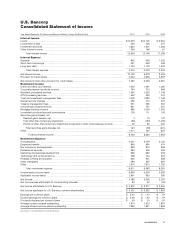US Bank 2011 Annual Report Download - page 65
Download and view the complete annual report
Please find page 65 of the 2011 US Bank annual report below. You can navigate through the pages in the report by either clicking on the pages listed below, or by using the keyword search tool below to find specific information within the annual report.These measures are viewed by management as useful
additional methods of reflecting the level of capital available
to withstand unexpected market or economic conditions.
Additionally, presentation of these measures allows investors,
analysts and banking regulators to assess the Company’s
capital position relative to other financial services companies.
Regulatory assessments of the Company’s financial stress
projections are influenced by measures using anticipated Basel
III definitions. These measures differ from capital ratios
defined by current banking regulations principally in that the
numerator excludes trust preferred securities and preferred
stock, the nature and extent of which varies among different
financial services companies. These measures are not defined
in generally accepted accounting principles (“GAAP”) or
federal banking regulations. As a result, these measures
disclosed by the Company may be considered non-GAAP
financial measures.
Because there are no standardized definitions for these
measures, the Company’s calculation methods may differ
from those used by other financial services companies. Also,
there may be limits in the usefulness of these measures to
investors. As a result, the Company encourages readers to
consider the consolidated financial statements and other
financial information contained in this report in their entirety,
and not to rely on any single financial measure.
Accounting Changes
Note 2 of the Notes to Consolidated Financial Statements
discusses accounting standards adopted in 2011, as well as
accounting standards recently issued but not yet required to
be adopted and the expected impact of these changes in
accounting standards. To the extent the adoption of new
accounting standards materially affects the Company’s
financial condition or results of operations, the impacts are
discussed in the applicable section(s) of the Management’s
Discussion and Analysis and the Notes to Consolidated
Financial Statements.
Critical Accounting Policies
The accounting and reporting policies of the Company
comply with accounting principles generally accepted in the
United States and conform to general practices within the
banking industry. The preparation of financial statements in
conformity with GAAP requires management to make
estimates and assumptions. The Company’s financial position
and results of operations can be affected by these estimates
and assumptions, which are integral to understanding the
Company’s financial statements. Critical accounting policies
are those policies management believes are the most important
to the portrayal of the Company’s financial condition and
results, and require management to make estimates that are
difficult, subjective or complex. Most accounting policies are
not considered by management to be critical accounting
policies. Several factors are considered in determining whether
or not a policy is critical in the preparation of financial
statements. These factors include, among other things,
whether the estimates are significant to the financial
statements, the nature of the estimates, the ability to readily
validate the estimates with other information (including third-
parties sources or available prices), and sensitivity of the
estimates to changes in economic conditions and whether
alternative accounting methods may be utilized under GAAP.
Management has discussed the development and the selection
of critical accounting policies with the Company’s Audit
Committee.
Significant accounting policies are discussed in Note 1 of
the Notes to Consolidated Financial Statements. Those
policies considered to be critical accounting policies are
described below.
Allowance for Credit Losses The allowance for credit losses is
established to provide for probable losses incurred in the
Company’s credit portfolio. The methods utilized to estimate the
allowance for credit losses, key assumptions and quantitative
and qualitative information considered by management in
determining the appropriate allowance for credit losses are
discussed in the “Credit Risk Management” section.
Management’s evaluation of the appropriate allowance
for credit losses is often the most critical of all the accounting
estimates for a banking institution. It is an inherently
subjective process impacted by many factors as discussed
throughout the Management’s Discussion and Analysis section
of the Annual Report. Although risk management practices,
methodologies and other tools are utilized to determine each
element of the allowance, degrees of imprecision exist in these
measurement tools due in part to subjective judgments
involved and an inherent lagging of credit quality
measurements relative to the stage of the business cycle. Even
determining the stage of the business cycle is highly subjective.
As discussed in the “Analysis and Determination of Allowance
for Credit Losses” section, management considers the effect of
imprecision and many other factors in determining the
allowance for credit losses. If not considered, incurred losses in
the portfolio related to imprecision and other subjective factors
could have a dramatic adverse impact on the liquidity and
financial viability of a bank.
Given the many subjective factors affecting the credit
portfolio, changes in the allowance for credit losses may not
directly coincide with changes in the risk ratings of the credit
portfolio reflected in the risk rating process. This is in part
due to the timing of the risk rating process in relation to
changes in the business cycle, the exposure and mix of loans
within risk rating categories, levels of nonperforming loans
and the timing of charge-offs and recoveries. For example, the
amount of loans within specific risk ratings may change,
providing a leading indicator of improving credit quality,
while nonperforming loans and net charge-offs continue at
U.S. BANCORP 63
























